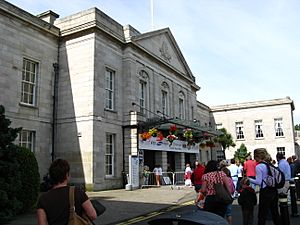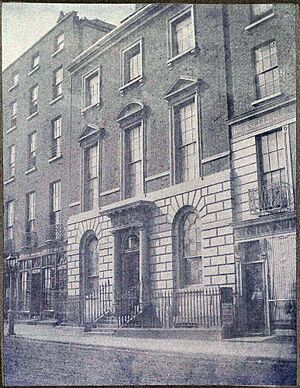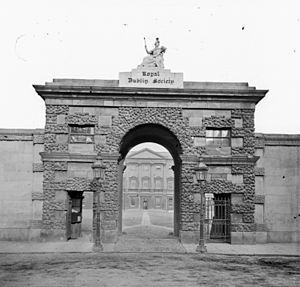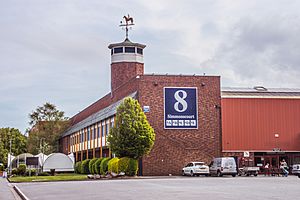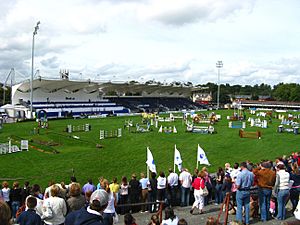Royal Dublin Society facts for kids
 |
|
| Abbreviation | RDS |
|---|---|
| Formation | 25 June 1731 |
| Type | Charitable |
| Purpose | To see Ireland thrive culturally and economically |
| Headquarters | Ballsbridge, Dublin, Ireland |
|
Region
|
Ireland |
|
President
|
Prof Owen Lewis |
|
Formerly called
|
The Dublin Society (1731–1820) |
The Royal Dublin Society (RDS) is an Irish group that helps Ireland grow in culture and economy. It started on June 25, 1731, as the 'Dublin Society'. It was very active in farming and helped create Ireland’s national library and museums.
The RDS is well-known for its large campus in Ballsbridge, Dublin, Ireland. This campus has places like the 'RDS Arena', 'RDS Simmonscourt', and 'RDS Main Hall'. These are used for many events, including shows, concerts, and sports. Famous events include the Dublin Horse Show and Leinster Rugby games. King George IV gave the RDS its "Royal" title in 1820. The RDS also has a club for its members, offering special access to events and meals.
The RDS is one of nine groups that can suggest people for the Seanad Éireann (Ireland's upper house of parliament) elections. These people work on farming issues.
Contents
A Look at RDS History
The RDS was started by members of the Dublin Philosophical Society. They wanted to improve farming, manufacturing, and other useful skills in Ireland. They added "and Sciences" to their name shortly after. The main goal was to boost Ireland's economy and create jobs. At first, the RDS focused on farming methods, planting trees, and growing crops like flax.
In 1738, Samuel Madden started a "premium" scheme. This offered rewards or grants to people who made improvements in Irish farming and arts. He helped raise money for this, and by 1740, awards were given for things like pottery, cotton, leatherwork, and even to painters and sculptors.
The Irish Parliament began giving money to the Dublin Society in 1761. This helped the Society give out more awards. This funding continued for many years, helping the RDS support agriculture, arts, and manufacturing.
The "Royal" part was added to the name in 1820 when King George IV became a supporter. Even after Ireland became independent, the RDS kept its "Royal" title.
In 1989, Dr. Dervilla Donnelly became the first female president of the RDS. This was a big moment for the Society. In 2018, An Post (Ireland's postal service) even made stamps to celebrate the Royal Dublin Society.
Arts and Creativity
Because of the success of its art awards, the RDS decided to open an art school. In 1750, the drawing school started, teaching figure drawing, landscapes, and architecture. It was free to attend and very popular. A famous student was James Hoban, who later designed the White House in Washington DC. Many other well-known artists also studied there or won awards from the RDS.
In 1867, the government took over the RDS art school. It later became the National College of Art and Design.
Today, the RDS still supports art through the RDS Visual Art Awards. These include the RDS Taylor Art Award, which has been given since 1878. This award helps young Irish artists. Many famous artists have won this award, including William Orpen and Louis le Brocquy.
Music and Performances
The RDS has a long history with classical music, going back to 1886. It hosted many concerts with music by famous composers like Haydn and Beethoven. Over the years, many famous musicians, such as Jessye Norman and Nigel Kennedy, performed at the RDS.
Since 1983, the RDS has been the main place for Feis Ceoil, a big music competition. The RDS also gives out music bursaries (scholarships) to talented young musicians. These awards help them with their studies and give them chances to perform.
Farming and Nature
Farming has always been a key focus for the RDS since it began. In its early years, the Society shared new ideas on farming. They published information on growing crops, draining land, and managing bees. They also showed how to use new farm machines.
Planting trees was also very important. Between 1766 and 1806, over 55 million trees were planted in Ireland because of the RDS's efforts.
The Botanic Gardens in Dublin started with the Dublin Society. In 1790, with government money, the Society leased land in Glasnevin. They wanted to teach the public about plants. The Botanic Gardens opened in 1800 and were managed by the RDS until 1877.
In 1845, the RDS detected early signs of the potato blight at the Botanic Gardens. This disease later caused a terrible famine in Ireland. The Society tried to find a cure, but they were not successful.
The first Spring Show was held in 1831 to encourage better animal breeding. Farmers showed off their best livestock. By 1848, the quality of Irish cattle was so good that English breeders wanted to buy them. The Spring Show moved to the RDS grounds in Ballsbridge in 1881 and continued until 1992.
Today, the RDS still supports farming. It gives out awards for forestry and woodlands. It also works on plans for "Climate Smart Agriculture" in Ireland. The Society continues to award prizes for the best cattle.
Science and Discovery
In the early days, science was closely linked to farming and industry. The Botanic Gardens, for example, were important for both science and agriculture. Later, science began to grow on its own. The RDS funded professors in chemistry and physics in the 1790s. They also bought a large collection of minerals.
The Dublin Society started holding science lectures in 1797. By 1824, these lectures on physics and chemistry were open to everyone. In 1903, the RDS brought radium to Ireland for the first time. Scientists John Joly and Walter Stevenson developed an early cancer treatment, known as the 'Dublin method', which gained international fame.
The Young Scientists and Technology Exhibition began in 1965. It has been held at the RDS every year since 1966. This event encourages young people to explore science and technology.
Today, the RDS continues to promote science in Ireland. It awards the Boyle Medal every two years for outstanding scientific research. This is Ireland's most important science award. The RDS also runs Science Blast, an event that gets over 10,000 primary school students excited about science, technology, engineering, and math (STEM). They also train teachers to help them teach science better in classrooms.
RDS Locations
The RDS has had several homes over the years.
Early Homes
The Society built its first headquarters on Grafton Street around 1766. Later, in 1796, they moved to a larger building on Hawkins Street. In 1815, the RDS bought Leinster House, which is now where the Irish Parliament meets. They created a natural history museum there.
Ballsbridge Campus
The RDS moved to its current large campus in Ballsbridge in 1879. It has grown to cover 40 acres. This campus includes several exhibition halls, the RDS Arena for sports, meeting rooms, and restaurants. It also has the "RDS Simmonscourt Pavilion," a big indoor venue.
RDS Main Hall
The RDS Main Hall is a major place for exhibitions, concerts, and other events in Dublin. It hosts the Young Scientist and Technology Exhibition every January.
RDS Simmonscourt
The RDS Simmonscourt is a large indoor venue that can hold about 7,000 people. It can also be divided into smaller spaces. It has hosted many concerts by bands like Thin Lizzy, Queen, and AC/DC. It also hosted the Eurovision Song Contest in 1981 and 1988. During the Dublin Horse Show, the show jumping horses stay here.
| Preceded by Centenary Palace Brussels |
Eurovision Song Contest Venue 1988 |
Succeeded by Palais de Beaulieu Lausanne |
| Preceded by Nederlands Congresgebouw The Hague |
Eurovision Song Contest Venue 1981 |
Succeeded by Harrogate International Centre Harrogate |
RDS Arena
The RDS Arena is famous for horse riding events, especially the annual Dublin Horse Show. It's also used for other sports like football and rugby. The Leinster Rugby team plays its home games here. The arena has different stands, including the old Anglesea Stand and the Grandstand.
You can get to the RDS easily by public transport. The DART train has stops nearby, and several bus routes stop right outside the Main Hall.
Exciting Events at the RDS
Dublin Horse Show
The first Dublin Horse Show was in 1864. It has grown into a huge international show jumping competition and a major entertainment event in Ireland. In 1982, the RDS hosted the Show Jumping World Championships as part of the Horse Show. The show has over 130 classes, including showing, performance, and show jumping.
In 2020, the Dublin Horse Show was cancelled due to the COVID-19 pandemic. This was the first time it had been cancelled since 1940. In August 2025, the RDS hosted the 150th Dublin Horse Show. Princess Anne attended the opening day, presenting awards and meeting people from horse charities.
Concerts and Music
The RDS Arena has become a popular place for concerts by many rock, heavy metal, and pop artists.
Bruce Springsteen has played there many times since 1988. He has performed for huge crowds, sometimes over 100,000 people! Other famous performers include Iron Maiden, Bon Jovi, Michael Jackson, Tina Turner, Kylie Minogue, and Metallica. U2 also played two concerts there in 1993.
The Eurovision Song Contest was held in the Simmonscourt Main Hall in 1981 and 1988. Celine Dion won in 1988.
Sports Events
The RDS is the home of Leinster Rugby, who play their home matches here. It has also hosted football games for Shamrock Rovers F.C. and international matches for the Republic of Ireland national football team. The FAI Cup finals were held here in 2007 and 2008.
In 1983, the RDS hosted a Davis Cup tennis match between Ireland and the United States. This match featured famous player John McEnroe.
Other Events
The RDS also hosts exams for University College Dublin and Trinity College Dublin. In 1986, the famous Bolshoi Ballet performed there for three days. In April 2023, the Irish Poker Open was held at the RDS.
Awards for Excellence
Boyle Medal for Science
The Boyle Medal is named after Robert Boyle, a famous scientist. It started in 1899 and is given by the RDS for amazing scientific research in Ireland. It is Ireland's most respected science award. Many brilliant scientists have received this medal.
Past winners of the Boyle Medal include:
- 2014 Seamus J. Martin
- 2011 Margaret Murnane
- 2009 Luke O'Neill
- 2005 Garret A. FitzGerald
- 2003 John McCanny
- 2001 Derek Ernest Gilmor Briggs
- 1999 Thomas Cotter
- 1996 Patrick Cunningham
- 1992 Brendan K. P. Scaife
- 1988 Peter Kevin Carroll
- 1986 James Robert McConnell
- 1982 David Allardice Webb
- 1981 Roy C. Geary
- 1979 Cormac O'Ceallaigh
- 1978 George Francis Mitchell
- 1972 John Lighton Synge
- 1971 Patrick Joseph Nolan
- 1970 Thomas J. Walsh
- 1969 Vincent C. Barry
- 1967 Edward J. Conway
- 1961 Phyllis E. M. Clinch
- 1959 Robert McKay
- 1950 Edmond J. Sheehy
- 1947 John Hewitt Jellet Poole
- 1945 Thomas J. Nolan
- 1942 Joseph Doyle
- 1939 Joseph Reilly
- 1936 Horace Hewitt Poole
- 1933 Paul A. Murphy
- 1931 Sir John Purser Griffith
- 1928 Walter Ernest Adeney
- 1928 William Ringrose Gelston Atkins
- 1921 George Herbert Pethybridge
- 1917 John Alexander McClelland
- 1916 Henry Horatio Dixon
- 1912 Sir Howard Grubb
- 1911 John Joly
- 1899 Thomas Preston
- 1899 George Johnstone Stoney
Images for kids
See also
 In Spanish: Royal Dublin Society para niños
In Spanish: Royal Dublin Society para niños


